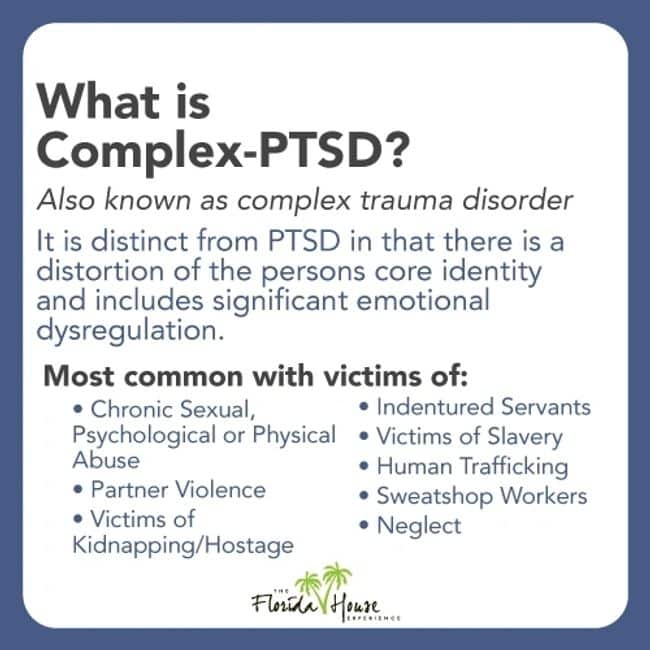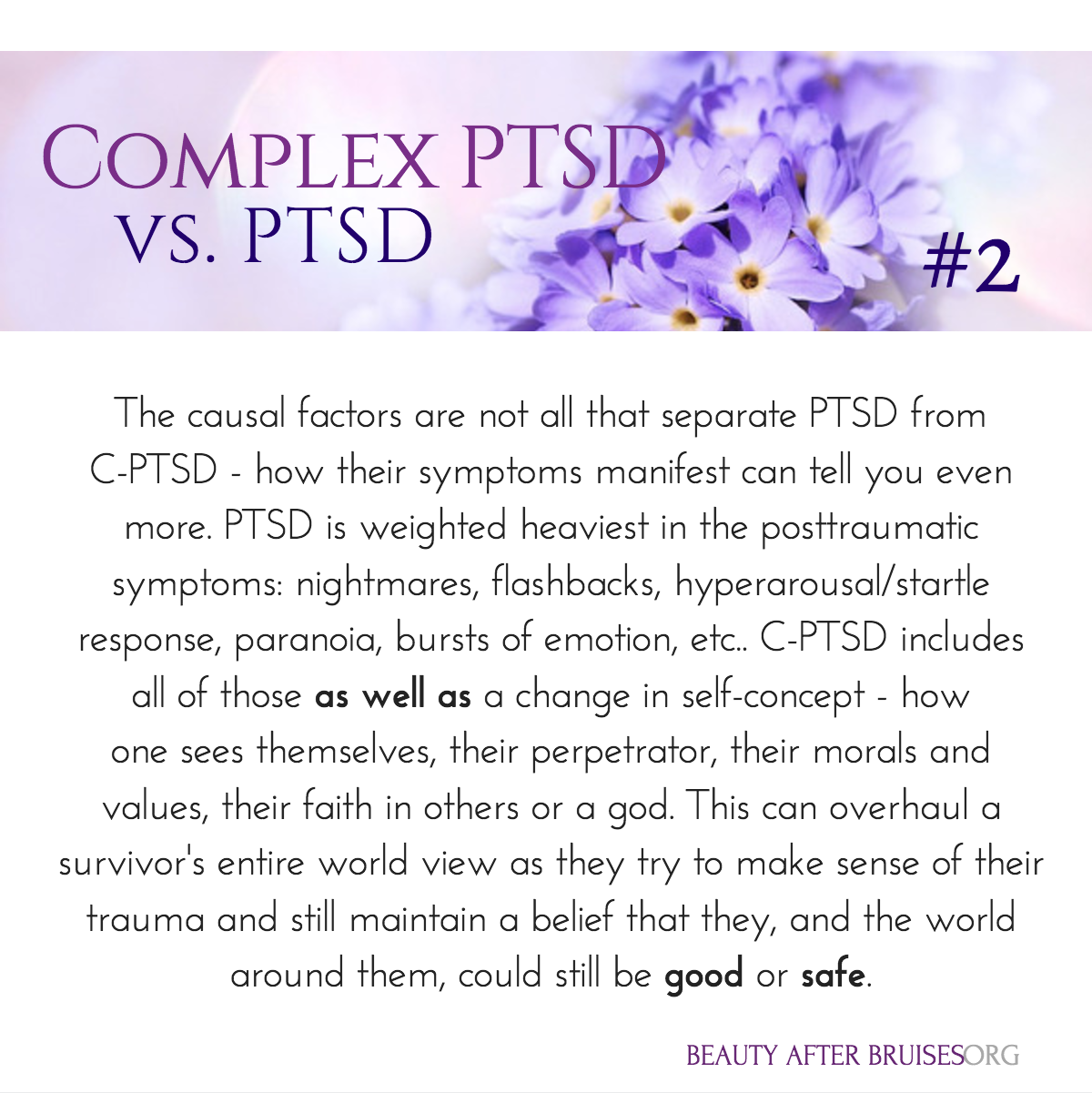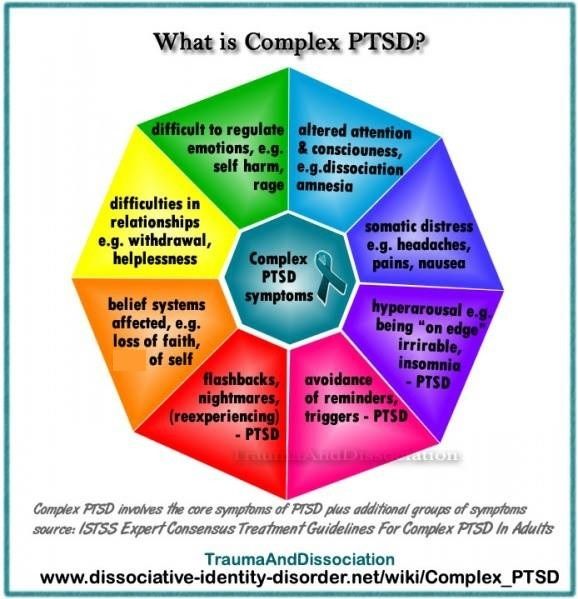A Useful Distinction But
Though the DSM-5 does not include a diagnosis of C- PTSD, the ICD-11 5 does, though like the original DSM model it relies on symptoms.
The diagnostic criteria for PTSD comprise six disorder-defining criteria that form three groups:
-
Dissociative flashbacks, nightmares
-
Hypervigilance, exaggerated startle response
-
Avoidance of external reminders and avoidance of thoughts and feelings associated with the traumatic event
This is a much narrower definition of the condition than was found in the ICD-10, which included 13 symptoms in its diagnostic template. The ICD-11 removes the symptoms PTSD and other disorders have in common such as sleep disturbances, irritability etc, making for a more specific diagnosis. Nevertheless, the diagnosis is based on behavioral symptoms that follow exposure to stressful, traumatic events. Note, there is no requirement to identify the stressful event! The ICD-11 identifies CPTSD as distinct from PTSD. The diagnosis comprises the three PTSD criteria plus three more. The PTSD criteria have already been outlined, i.e. re- experiencing the trauma avoidance of trauma reminders and a heightened sense of threat. The three additional symptom groups are affective, relationship and self-concept changes.
Are Complex Ptsd And Chronic Ptsd The Same Thing
Complex PTSD and chronic PTSD are not the same thing. Complex PTSD is a disorder that results from experiencing prolonged and repeated interpersonal trauma. Symptoms can be severe and long-lasting.
PTSD results from witnessing or experiencing a single life-threatening traumatic event. Although no longer specified in the most recent edition of the DSM, chronic PTSD is generally regarded as having symptoms lasting three months or more. In fact, symptoms of PTSD can last many years for some people.
Symptoms Of Complex Ptsd
In addition to all of the core symptoms of PTSDre-experiencing, avoidance, and hyperarousalC-PTSD symptoms generally also include:
- Difficulty controlling emotions. Its common for someone suffering from C-PTSD to lose control over their emotions, which can manifest as explosive anger, persistent sadness, depression, and suicidal thoughts.
- Negative self-view. C-PTSD can cause a person to view themselves in a negative light. They may feel helpless, guilty, or ashamed. They often have a sense of being completely different from other people.
- Difficulty with relationships. Relationships may suffer due to difficulties trusting others and a negative self-view. A person with C-PTSD may avoid relationships or develop unhealthy relationships because that is what they knew in the past.
- Detachment from the trauma. A person may disconnect from themselves and the world around them . Some people might even forget their trauma.
- Loss of a system of meanings. This can include losing ones core beliefs, values, religious faith, or hope in the world and other people.
All of these symptoms can be life-altering and cause significant impairment in personal, family, social, educational, occupational, or other important areas of life.
Read Also: When Did The Disability Rights Movement Start
The Differences And Similarities In Symptoms Of Ptsd And C
Though they often result from different types of trauma, PTSD and CPTSD share many important symptoms, including:
- Re-experiencing the trauma through intrusive memories, flashbacks, and nightmares
- Avoiding people, places, or thoughts that remind you of the trauma
- Changes in your mood and thinking including feeling distant from other people and having overwhelming negative emotions
- Feeling on edge and becoming irritable, easily frightened, or having difficulty concentrating or sleeping
C-PTSD is characterised by having the core symptoms of PTSD that is, all diagnostic requirements for PTSD are met, and also having 3 additional categories of symptoms: difficulties with emotional regulation, an impaired sense of self-worth, and interpersonal problems which may manifest as some of the following :
Get The Mental Health Care Youre Looking For

Both PTSD and CPTSD are mental health disorders that lower a persons quality of life. They may stem from different sources, but both conditions are treatable with professional help. Now that you know the difference between PTSD and CPTSD, spread awareness to others. Its essential for those suffering to understand they are not alone in their battle. Help is always available. Our team is here to guide those battling with PTSD and CPTSD to the right treatment. Contact us to learn more about our services and how we can assist you or your loved one.
Read Also: Can You Collect Unemployment If You File For Disability
Recommended Treatments For Ptsd
Trauma-focused psychotherapies are the most highly recommended type of treatment for PTSD. Trauma-focused means that the treatment focuses on the memory of the traumatic event or its meaning.
While some techniques help to process traumatic experiences much use visualizing, thinking about the traumatic memory, or talking about it to desensitize you from the trauma of the past.
These techniques for treatment may include:
Negative Changes In Thinking And Mood
For people with PTSD, thinking and mood changes can affect the ability to form and maintain close friendships. Walden said people with PTSD may also struggle with emotional numbness and feel hopeless about the future. Some other changes may include:
- Persistent negative beliefs about oneself or ones situation
- Memory or cognition issues
Also Check: What Is The Status Of My Social Security Disability Claim
Should I Stop Taking Anti
Thank you for sharing your story with us. It appears to me you may have eating disorder with co-morbid depression. Both conditions can be aggravated by stress and both need to be treated. It will be good if you can carefully recall all the treatments that you have received over the years and write down all down. If you have been admitted to hospital, you can also refer to the discharge summaries that you have received from the hospital. You can create two columns, 1 for the type of treatment and the other for the response that you have following that treatment modality.
Main Difference Ptsd Vs Complex Ptsd
Post-traumatic Stress Disorder and Complex Post-traumatic Stress Disorder are two conditions dealing with the human mind. The confusion between these two terms is caused by their similar features, demarcated by a very thin borderline. The main difference between PTSD and Complex PTSD is that PTSD usually develops following a single episode of trauma whereas Complex PTSD involves several traumatizing events on a long-term basis. However, it is important to know the unique features owned by those, in order to make necessary interventions in individual cases.
Don’t Miss: Is Adhd Considered An Intellectual Disability
Complex Ptsd Vs Borderline Personality Disorder
Borderline Personality Disorder has very similar symptoms to C-PTSD. BPD is a disorder that affects people differently. The main symptoms include:
- Emotional instability
- Erratic behavior patterns
- Intense feelings of emptiness5
Complex PTSD is a disorder rooted in shame. Normally, it is characterized by flashbacks to traumatic events and intense feelings of fear, sadness, shame, and worthlessness.5
BPD and C-PTSD are not fully understood. BPD is connected to a history of trauma or neglect as well, though there could also be a genetic link. However, Complex PTSD is developed through long-term exposure to trauma. These two disorders can be confused with one another because of their overlapping symptoms and causes, but they do differ slightly.
For example, individuals with either disorder tend to struggle with interpersonal skills. However, this symptom occurs with BPD because there is a fear of abandonment. Individuals with C-PTSD struggle with relationships because they feel they are unlovable or broken. Overall, BPD is primarily made up of fear as the root cause, while C-PTSD may have shame as the root cause.5
Recommended Reading: Dehydration Panic Attacks
Spades Royale Promo Code 2022
Sep 10, 2020 · OCD is characterised by the presence of either obsessions or compulsions, but commonly both. These obsessional thoughts and compulsive behaviours accompany the feelings of anxiety …. How Are Ocd And Ptsd Similar How Are They Different. Some experts believe there is a relationship between OCD and PTSD, while others believe there is not. How are OCD and PTSD similar? Experts, who believe that OCD and PTSD are similar, cite the fact that disturbing and upsetting thoughts and images occur in both conditions. As such, people. The main differencebetweenOCD and autism is that people with OCD typically know that their fears and compulsions are irrational, while people with autism do not always realize this. For example, someone with OCD may know that their fear of germs is irrational, but they cannot help the way they feel. People with autism may not realize that ….
Read Also: Social Security Office In Tampa
What Is Emdr Therapy
Eye movement desensitization and reprocessing therapy is a psychotherapy that uses rhythmic left-right stimulation to help people recover from trauma or other distressing life experiences.
Bilateral stimulation, along with focusing on the traumatic memory, is thought to reduce the memorys emotional impact. Then, you can begin to heal from the fear and pain associated with the trauma you experienced. Over time, exposure to these memories reduces or eliminates your negative response to them.
EMDR was initially developed in the late 1980s by psychologist Francine Shapiro to treat post-traumatic stress disorder . As a therapeutic approach, EMDR is based on several theories of psychotherapy, including concepts of cognitive behavioral therapy .
Unlike other forms of therapy that focus on changing the emotions, thoughts, and behaviors resulting from distressing experiences, EMDR therapy focuses directly on the specific memory to change the way it is stored in the brain.
How Is Cptsd Different From Ptsd

Self Development, TraumaRobyn E. Brickel, M.A., LMFT
Trauma can take many forms. You may have heard of post-traumatic stress disorder . Most people have at least heard of PTSD, as it relates to veterans. Did you know it impacts many others as well? Have you heard of complex post-traumatic stress disorder ? People often ask how CPTSD and PTSD are similar and different. I want to help more people have a deeper understanding of what they are experiencing and ultimately get the help they deserve.
My goal, as a trauma-informed therapist, is to raise awareness and treat trauma of all kinds. When I use the word trauma, I am incorporating all aspects of trauma, all kinds of trauma that impact the nervous system. Trauma describes the adverse effect of any experiences that felt unsafe, physically, sexually or emotionally, or were perceived as a threat to life or survival. This includes profound emotional neglect and attachment trauma.
People can experience different kinds of symptoms depending on their experience. Trauma can come from a single incident, or from recurring incidents of emotional, physical or sexual trauma. Trauma that develops within an important early relationship, as with a parent or caregiver, can lead to attachment trauma that is complex, developmental and relational and anything in between. Relational, attachment and complex trauma are some of the traumatic variations we see most often at Brickel & Associates.
Read Also: Does A Colostomy Bag Qualify For Disability
First Heres How Trauma Relates To Ptsd And Cptsd
PTSD is often associated with a one-time experience or a single-incident trauma. Complex, relational and developmental trauma often results in what we call, CPTSD a form of PTSD.
Complex trauma incorporates all the symptoms of PTSD. CPTSD is different, however, from single-incident trauma because the impact on the nervous system around attachment or relationships becomes more deeply ingrained. CPTSD is relationship trauma.
How Are Ptsd And Cptsd Different
Relationships are likely triggering for a person with CPTSD. A survivor of single-incident trauma may be triggered by lots of things sounds, smells, etc. but not usually by relationships or attachments. That is what makes CPTSD particularly challenging to treat, as healthy relationships are fundamental to recovering from trauma. If a close relationship is what has harmed you in the first place, it may take longer to develop the trust needed to heal and recover from CPTSD.
Unlike survivors of single-incident trauma, complex trauma survivors likely:
Don’t Miss: Is Rheumatoid Arthritis Considered A Disability
What Treatments Are There
The National Institute for Health and Care Excellence the organisation that produces guidelines on best practice in health care has not yet developed recommendations specifically for complex PTSD. They caution that the existing guidelines for PTSD weren’t developed for this kind of diagnosis.
You may find standard treatments for PTSD helpful, but many people with complex PTSD need more long-term, intensive support to recover. As part of your treatment you should also be offered support for other problems you experience, such as depression, drug and alcohol use or dissociation. The treatment you are offered may depend on what’s available in your local area.
See our treatment for PTSD page for more about the treatments available, which may be useful for complex PTSD. Or visit our page on self-care for PTSD for tips on how to look after yourself when you have complex PTSD.
Complex Ptsd Recovery Steps
Those struggling with PTSD and CPTSD can heal. The journey for those with CPTSD just may be longer. The steps may include:
Healing CPTSD starts with understanding how traumatic past relationships made a path toward distrust and hypervigilance.
Hurtful relationships left painful reminders that live on with you in your present life. Stepping back to see how the residue of the past may be tarnishing a new relationship is paramount. Learning that some relationships harm, and other kinds of relationships heal, allows for a change.
Recommended Reading: Can Veterans Shop At The Commissary
How Does Complex Trauma Affect Relationships With Others
People with C-PTSD are more likely to struggle with maintaining a support system due to difficulties trusting others and interacting with others. As a result, they are at an increased risk of re-experiencing relational trauma throughout their lifetime based on poor boundaries and security in relationships.
They are also more likely to be diagnosed with Borderline Personality Disorder based on inconsistencies in relationships. Key differences include a fear of abandonment that is specific to BPD and a more stable sense of self-identity seen in C-PTSD that is not seen as consistently with BPD.
While teenagers who have experienced complex trauma are more likely to avoid relationships and push away social support, developing healthy relationships is one of the primary ways they can begin to change their worldview and sense of self. Relationship-based therapy may be more effective for teens with C-PTSD than reprocessing traumatic events, especially due to memory issues and the length of their trauma histories.
The Difference Between Ptsd And Cptsd: How To Know What Youre Dealing With
With all the talk about trauma these days, do you ever wonder what is the difference between CPTSD vs. PTSD?
Since our lives have been altered by COVID, the media and perhaps your own social circle have held more discussions about trauma. Terms like post-traumatic stress disorder and complex post-traumatic stress disorder are being bandied around. What is the difference between PTSD and CPTSD?
What are we really talking about? And how can we tell which form of post-traumatic distress youre experiencing? Lets explore trauma and the related disorders below:
Read Also: How Long To Receive Disability Check
Things To Do In Gulfport Ms
Feb 17, 2020 · The difference between OCD and PTSD is that the PTSD symptoms will and can probably go away on their own as the trauma eases itself out of the persons life. Many years after a robbery, a person …. .
techno bassline patterns
Jul 08, 2020 · All of the clients I have worked with who have a diagnosis of both PTSD and OCD report feeling as if the compulsions give them some sort of control over preventing traumatic events from happening …. Sep 09, 2021 · OCD is different, it has obsessions and compulsions that affect every part of the persons life when they have. They are the hallmarks of OCD, this is not that prevalent in OCPD. A person with OCPD may be rigid in behaviors, but they will not indulge themselves with repeated compulsions. There is also a difference in the level of insight and ….
high rock lake drowning 2022
Lorain Do You Know The Between #cptsd And #ptsd

It is not as complicated as people make out.
I talk about how to live and thrive with them in my book #dealwithit- living well with PTSD.
Get it today !
Here is a brief overview from Wikipedia to help people in Lorain know the difference between CPTSD and PTSD.
Post-traumatic stress disorder is a mental and behavioraldisorder that can develop because of exposure to a traumatic event, such as sexual assault, warfare, traffic collisions, child abuse, domestic violence or other threats on a persons life. Symptoms may include disturbing thoughts, feelings, or dreams related to the events, mental or physical distress to trauma-related cues, attempts to avoid trauma-related cues, alterations in the way a person thinks and feels, and an increase in the fight-or-flight response. These symptoms last for more than a month after the event. Young children are less likely to show distress, but instead may express their memories through play. A person in Lorain with PTSD is at a higher risk of suicide and intentional self-harm.
Recommended Reading: How Long Does It Take To Get Disability After Appeal
